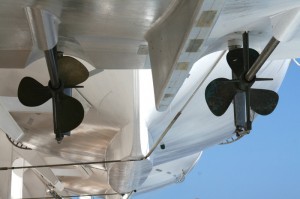 You have a boat. You are learning the ropes and beginning to appreciate the performance aspect of your boat. As a new or experienced boat owner, there may come a time when there is a need to improve the boat’s performance. The simplest and most economical solution is buying a new set of propellers. While this may sound simple, it is anything but that. It is economical but not simple unless you are mathematical.
You have a boat. You are learning the ropes and beginning to appreciate the performance aspect of your boat. As a new or experienced boat owner, there may come a time when there is a need to improve the boat’s performance. The simplest and most economical solution is buying a new set of propellers. While this may sound simple, it is anything but that. It is economical but not simple unless you are mathematical.
Looking to improve your go-fast boat’s performance but don’t have the bank for something such as a supercharger. Keep in mind that you want to be able to achieve the proper full-throttle operating rpm that the engine manufacturer recommends. If a propeller is too small—meaning its pitch is too low for the power—the engines will run on their rev-limiters, which keep them from over-spinning and damaging themselves. If a propeller is too big—meaning the pitch is too high for the power—the engines can be 200 to 300 rpm (or more) short of their peak operating range.
According to boat experts, if you over-prop, you end up with a boat that is somewhat doggy everywhere with the exception of the top-end and even then, it takes a long time to get there. If you’re under-propped, you might have good acceleration and good rough-water handling, but in flat water you might be losing mph on the top-end.
There is no “perfect” propeller set for any given boat. Propping with top-end as your main priority likely means choosing the biggest propeller your engines and drives can spin, and that also likely means standing-start and midrange acceleration will suffer. Propping for good all-around performance could mean making a lower-pitch, conservative prop choice that will cost you up top. Some experts recommend setting up a strategy that balances the equation of over-propping and under-propping.
Diameter is a critical element of propeller selection. It is particularly crucial in catamarans, where in all but the largest cat you should opt for smaller-diameter propellers. Smaller-diameter propellers usually make cats feel more settled down. But on a heavy V-bottom, it is recommended to go for the biggest-diameter props that can be found.
A hot topic these days with regards to propeller selection is propeller rake angle—the angle of the blade as it “leans back”—also plays a role. Lower rake-angle propellers tend to provide less bow lift, which translates to higher stern lift. Conversely, higher rake-angle props tend to produce less stern lift and greater bow lift.
Last, but far from least, there is propeller rotation. In outboard rotation in a twin-engine setup, the starboard propeller turns to starboard and the port propeller turns to port. Switch the direction of rotation for each propeller and you have inboard rotation. Outboard rotation tends to create bow lift, whereas inboard rotation tends to create stern lift.
When propellers run inward you usually get better handling, but in dead-flat water, outboard rotation is usually faster. With V-bottoms, they generally run better with the props turning outboard if the engines are installed side by side, but better with the props turning inboard if the engines are staggered.
So are there perfect propellers for your boat? Only the boat owner knows the answer to this question. It all comes down to where you use your boat, what you use your boat for, and how you want it to operate. The performance of your boat can be determined by the propellers just like the tires on a car. Let the experts guide you and make sure you brush up on your math skills.
Picking The Right Propeller.” Picking The Right Propeller. N.p., n.d. Web. 28 June 201
Follow Us: Facebook – Foursquare – Twitter – YouTube – LinkedIn
